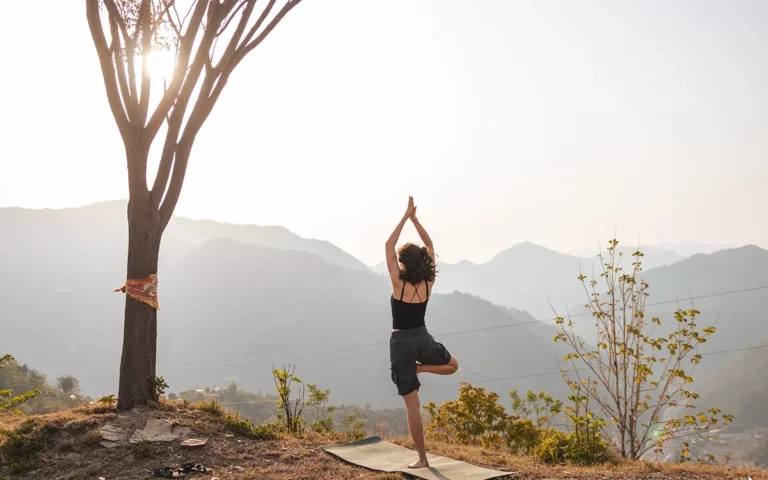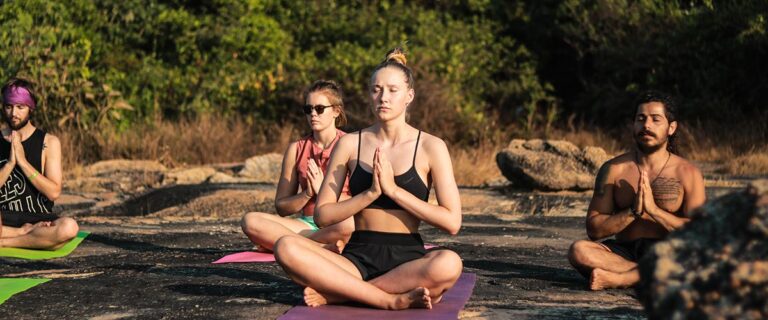Couples Yoga: Benefits, Poses to Strengthen Your Relationship
Having a loved one by your side is the most comfortable feeling while stepping into an uncomfortable situation. Our partners are the people we rely upon when something goes wrong. This same idea brought about the concept of ‘Couples Yoga.’ There is no better support system than your respective partners to achieve anything in this world.
Due to excess stress and different lifestyles, it is possible to drift away from your partners emotionally from time to time. The healthy way of dealing with a partner while living under the same roof is by creating enough space for two people’s vulnerability. When we disconnect from ourselves is when we disconnect from others. Hence, when we practice yoga, the focus is prioritizing our trauma first and working through it with the help of Asana, Pranayama, and Meditation practices. Once we accept our shortcomings, we work around them. Couples yoga is the therapy every couple needs if they are exhausted with their daily lives and are stuck somewhere in their mind.
The Essentials of Couples Yoga
- Communication: Open communication is the key. Discuss the intentions, comfort levels, and any physical limitations before starting with the practice.
- Trust: trusting the partner is the foundation. Many poses require you to rely on each other’s support.
- Warm-up: Beginning with gentle stretches or a brief pranayama session together can enhance relaxation and connection.
- Balance and Support: practice poses that involve balance and support, where one partner leans on the other or holds a position while the other provides support.
- Respect Boundaries: Be mindful of each other’s boundaries and comfort levels as pushing one another can become unsafe.
- Enjoy the time together: this will be a time that a couple can dedicate their time religiously to improve not just their physical health but also their mental health as a team.
Couples yoga can be a fulfilling way to bond with your partner emotionally and physically. The intention is not to master the poses but to nurture your relationship through shared movement and mindfulness.
Benefits of Couples Yoga
The physical benefits of Couples yoga are increased strength, balance, and flexibility where the motor skills also improve.
Physical Benefits:
- Increased Flexibility and Strength: Partner-assisted stretches and poses help improve flexibility as partners assist each other in deeper stretches, while other postures help to support each other which builds strength in the muscles.
- Enhanced body awareness: Couples yoga encourages awareness of body alignment and posture, helping partners to correct and improve their own alignment.
- Pain Relief: Assisted stretching in couples yoga can alleviate tension in muscles and joints, reducing pain and promoting relaxation.
Mental and Emotional Benefits:
- Trust and Communication: Partner Yoga fosters trust as partners rely on each other for support and balance. It also encourages clear communication to ensure safety and comfort during poses.
- Connection and Intimacy: Couples Yoga promotes a deeper emotional connection by sharing physical touch and synchronized movements. This can strengthen emotional bonds and increase intimacy.
- Stress Reduction: The combination of Physical activity, synchronized breathing, and mutual support can reduce stress levels and promote relaxation.
- Mindfulness and Presence: Practicing yoga together encourages partners to stay present in the moment, fostering mindfulness and reducing distractions from daily life.
- Fun and Playfulness: Couples yoga can be a lighthearted and enjoyable activity, promoting laughter and a sense of playfulness as partners explore new poses and challenges together.
- Relationship satisfaction: Research suggests that engaging in joint physical activities, like couples yoga, can enhance relationship satisfaction and overall happiness.
Popular Couples Yoga Poses
Couples yoga poses are designed to enhance connection, trust, and communication between partners. Below are some popular couples yoga poses:
- Partner Forward Fold:
- Stand facing each other, feet hip-width apart
- Hold hands and lean forward, keeping your backs straight and folding at the hips.
- This pose stretches the hamstrings and lower back while fostering a sense of connection through touch and balance.
- Double Downward Dog:
- One partner starts in a traditional downward dog position (Hands and feet on the floor, Hips high)
- Hold hands and lean back slightly, lifting your feet off the floor to bring your shins parallel to the ground.
- Both partners can adjust their positions to find balance and stretch through the spine and legs.
- Partner Boat pose:
- Sit facing each other, knees bent, and feet flat on the floor.
- Hold hands and lean back slightly, lifting your feet off the floor to bring your shins parallel to the ground.
- This pose strengthens the core muscles and requires coordination and balance between partners.
- Partner Backbend:
- One partner stands with feet hip-width apart, arms extended overhead.
- The other partner stands facing away and leans back, placing their hands on the thighs of the standing partner for support.
- This pose stretches the chest, shoulders, and front body while building trust and communication between partners.
- Partner Wheel pose:
- One partner lies on their back with knees bent and feet flat on the floor.
- The second partner stands behind the first partner’s head, holding their hands.
- The first partner pushes up into a bridge pose, while the second partner assists with stability and balance.
- This pose requires significant trust and communication as it involves weight-bearing and inversion.
These poses vary in difficulty and intensity, so its important to communicate with your partner and choose poses that feel comfortable and safe for both of you.
Challenges and Considerations
Couples yoga can be incredibly rewarding, but it also comes with its own set of challenges and considerations. The partners may have different levels of flexibility, strength, or body proportions, which can make certain poses challenging or uncomfortable for both partner.
Effective communication is crucial in couples yoga to ensure safety, comfort, and alignment. Miscommunication can lead to injury as some poses require partners to support each other’s weight. The patience level might also be challenged as partners may have different levels of experience with yoga.
It’s important to warm up with gentle stretches and cool down with relaxation poses like Savasana. Begin with simpler poses that both partners can comfortably achieve. Gradually progress to more advanced poses as trust and synchronization improve.
Props such as Yoga blocks, straps, or bolsters can assist in achieving poses and make them more accessible. Don’t hesitate to use modifications that suit both partners’ abilities. Encourage synchronized breathing to deepen the connection between partners and enhance relaxation during poses.
By addressing these challenges and considerations, couples can enrich their relationship through the practice of yoga, fostering physical well-being, trust, and emotional connection.
Integrating Couples Yoga into Your Routine
Integrating couples yoga into your routine can be a wonderful way to connect with your partner regularly while reaping the physical and emotional benefits of yoga together. Try to stick to a consistent schedule to establish a routine and make it easier to incorporate into your lifestyle. Choosing a quiet and comfortable space in your home where you can practice without distractions can help you increase the consistency of the practice.
Conclusion
Couples yoga can be a playful and enjoyable experience. Don’t be afraid to laugh at mistakes or challenges, it’s a part of the bonding process. Consider attending a couples yoga class or workshop led by an experienced instructor to learn proper techniques and receive personalized guidance.






